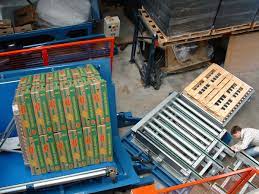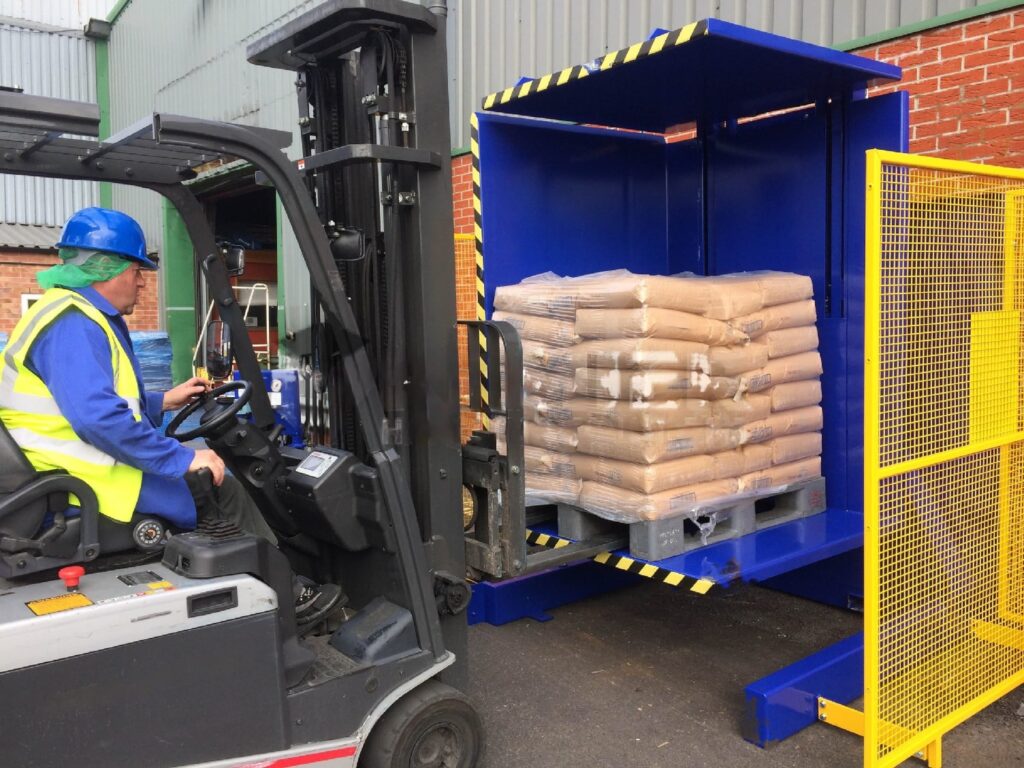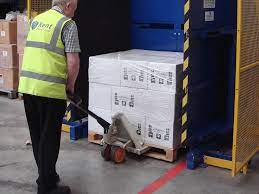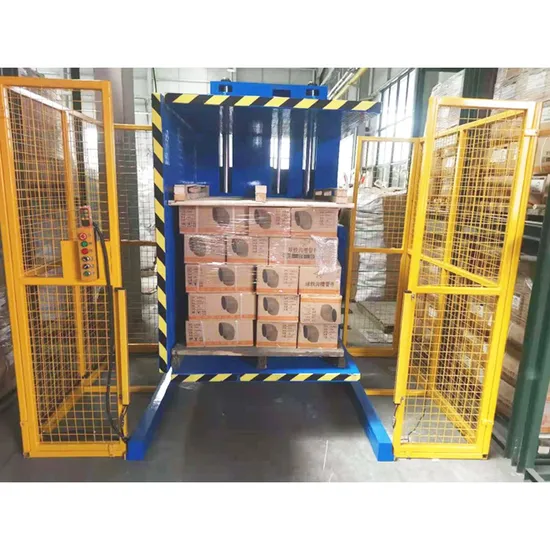Pallet Inverter: How Do You Protect Sensitive PCBs During Pallet Flips?
Imagine a full pallet of high-value Printed Circuit Boards (PCBs). Each board is critical for your production line. But this pallet needs to be swapped, maybe from an in-house wooden pallet to a plastic one for shipping. You bring in a standard pallet inverter. The machine clamps down and begins its flip. Then you hear it. A subtle crackle. The immense, uncontrolled pressure of a basic inverter has just turned thousands of dollars of sensitive electronics into a pile of scrap. This single event can halt production, miss shipping deadlines, and destroy your profit margins.
The best way to protect sensitive PCBs during pallet flips is to use a specialized pallet inverter equipped with adjustable, low-pressure clamping systems. These systems use sensors and precise controls to apply just enough force to secure the load without crushing the delicate components, ensuring a safe 180-degree rotation.

This might sound like a simple solution, but the engineering behind it is what separates a reliable process from a costly disaster. I have spent my career designing and building packing machinery. I have seen firsthand how the wrong equipment can undermine an otherwise efficient operation. In this article, I will share my experience. We will explore why standard inverters are a high risk for products like PCBs. We will also break down the specific features that guarantee a safe and efficient pallet exchange for your most fragile and valuable goods.
Why Do Standard Pallet Inverters Damage Sensitive PCBs?
You have a problem. Your logistics team reports damage to your PCBs after pallet swapping. Your first thought might be operator error. But the real issue is often the machine itself. You bought a pallet inverter to solve one problem, but it has created a much more expensive one. The machine, designed for brute force with robust goods like bags of cement or canned drinks, is now a threat to your high-tech components. Every flip becomes a gamble, and you are losing.
Standard pallet inverters damage PCBs because they are built for durability, not delicacy. They use high, often non-adjustable, clamping pressure designed to hold heavy, uniform loads. This brute-force approach applies excessive stress to the fragile solder joints, components, and boards themselves, leading to micro-cracks and complete failure.

Let's dive deeper into the specific forces at play. When you are moving tons of steel or other heavy materials, your main concern is that the load does not shift. The equipment is designed with this single goal in mind. But for PCBs, the priorities are completely different. It is not just about moving a load; it is about protecting the integrity of every single item within that load.
The Physics of Failure
Standard inverters often use a simple hydraulic system with a single pressure setting. This is a "one-size-fits-all" approach. The machine clamps the pallet with a force calculated to hold the maximum rated weight, whether you are flipping 200 kg or 2000 kg. For a pallet of PCBs, this is massive overkill. The pressure is not distributed evenly. It concentrates on the outer boxes and frame of the pallet. This pressure then transfers inward, flexing the boards and stressing the components.
Vibration and Rotational Speed
Another hidden danger is the rotation mechanism. Basic inverters often have a fixed, and relatively fast, rotational speed to maximize throughput. They start and stop abruptly. This creates significant G-forces and vibrations that ripple through the stack of PCBs. Solder joints, especially on fine-pitch components like BGAs (Ball Grid Arrays), are extremely vulnerable to this kind of shock. Micro-cracks can form that are invisible to the naked eye. These products might even pass initial testing, only to fail later in the field. This causes product recalls and serious damage to your company's reputation.
The table below breaks down the key differences between a standard system and one designed for sensitive products.
| Feature | Standard Pallet Inverter | PCB-Safe Pallet Inverter | Impact on PCBs |
|---|---|---|---|
| Clamping System | High, fixed hydraulic pressure | Adjustable, low-pressure electric or hydraulic system with sensors | Prevents crushing and board flexion. |
| Clamping Plates | Hard steel plates | Padded or soft-touch plates | Distributes force evenly, avoids point pressure. |
| Rotation Control | Fixed, fast speed with sudden starts/stops | Variable speed control with soft start/stop | Minimizes G-force and vibration, protecting solder joints. |
| Load Sensing | None or basic weight limit | Integrated pressure and position sensors | Provides real-time feedback to prevent over-clamping. |
In my early days as an engineer, I visited a factory that was losing nearly 10% of their motherboards during pallet exchange. They blamed their staff. But when we measured the clamping force of their inverter, it was exerting over five tons of pressure. It was designed to hold engine blocks. They were using a hammer to handle a watch. Understanding these mechanical details is the first step to finding a real solution that protects your assets and your bottom line.
What Key Features Make a Pallet Inverter Safe for Electronics?
Your team is frustrated. They are handling valuable electronics with care, but the equipment is letting them down. The fear of causing damage slows them down, or worse, they accept a certain level of loss as a "cost of doing business." This is not a sustainable way to operate. You know there must be a better tool for the job, a machine designed with precision in mind. A machine that gives your team the confidence to work efficiently without risking the product.
A pallet inverter safe for electronics must have three core features: a highly adjustable clamping pressure system, soft or non-marring clamping surfaces, and a smooth, controlled rotation with variable speed. These elements work together to handle the load gently, preventing shock, vibration, and physical damage.

These features are not just nice-to-haves; they are essential requirements for any company serious about quality control and operational efficiency. Let's look at each one in more detail. They represent the difference between a simple machine and a true packaging solution.
Feature 1: The Adjustable Clamping Pressure System
This is the most critical feature. The ability to precisely dial in the clamping force is everything. Modern electronics-safe inverters use advanced systems to achieve this.
- Electric Actuators: Instead of powerful but less precise hydraulics, many systems use electric actuators. These provide a much finer degree of control over both pressure and position.
- Pressure Sensors: The clamping plates are fitted with sensors. These sensors provide real-time feedback to the machine's controller. The operator can set a maximum pressure—for example, 300 kg. The machine will clamp until it reaches that pressure and then stop. This eliminates guesswork and ensures consistent, safe handling for every pallet.
- Load Height Detection: Some machines use lasers or ultrasonic sensors to detect the height of the load before clamping. This allows the machine to move the clamps into position quickly and then slow down for the final, gentle touch, improving cycle times without sacrificing safety.
Feature 2: Soft and Secure Clamping Surfaces
The material that touches your product matters. Standard inverters use bare steel plates. These can scratch, dent, or apply concentrated pressure points to the outer cartons.
- Rubber or Urethane Padding: The best machines have clamping plates lined with thick, durable rubber or a high-durometer urethane. This padding serves two purposes. First, it cushions the load and distributes the clamping force over a wider surface area. Second, the high-friction surface helps to hold the load securely with less overall pressure. You don't need to squeeze as hard if the grip is better.
Feature 3: Smooth, Controlled Rotation
The way a load is turned is just as important as how it is held. A jerky, fast rotation can be just as damaging as too much pressure.
- Variable Frequency Drive (VFD): The motor that drives the rotation should be controlled by a VFD. This technology allows the operator to control the acceleration and deceleration of the rotation. This is often called "soft start" and "soft stop." The machine ramps up to speed slowly, rotates smoothly, and then gently ramps down before stopping. This eliminates the sudden shocks that can break delicate components.
- Programmable Speeds: The ability to set different rotational speeds for different products adds another layer of control, further optimizing the process for both safety and efficiency.
Here is how these features directly address the common failure points for PCBs.
| Failure Point | Standard Inverter Action | PCB-Safe Inverter Solution | Benefit |
|---|---|---|---|
| Board Flexion | Over-clamping with hard plates | Low, controlled pressure with padded plates | Prevents micro-cracks on the board itself. |
| Component Shear | High G-force from sudden rotation | Soft start/stop via VFD control | Protects solder joints from shear stress. |
| Surface Damage | Steel plates scratch/dent packaging | Padded surfaces distribute force | Maintains product and packaging integrity. |
| Inconsistent Results | Operator dependent, no feedback | Sensor-based, repeatable pressure setting | Guarantees the same safe process every time. |
Investing in a machine with these features is not an expense. It is an investment in quality, efficiency, and risk reduction. It is a direct contribution to a higher uptime and a lower total cost of ownership, goals that any forward-thinking CEO like Javier would prioritize.
How Does Precise Clamping Pressure Protect Your Product Investment?
You are looking at the numbers. The cost of damaged goods, production downtime, and potential recalls adds up. You see that a single pallet of your product can be worth tens of thousands of dollars. Protecting that investment is not just about quality control; it is about financial stability. You need to be sure that your processes are not actively working against your profitability. The clamping system on your pallet inverter seems like a small detail, but its impact on your bottom line is huge.
Precise clamping pressure protects your product investment by applying the minimum force required to safely secure the load. This scientific approach, guided by sensors and automation, prevents product damage, reduces waste, and builds a reliable, repeatable process that eliminates the risk of human error or mechanical brute force.

Let's break down the mechanics and the financial impact of getting this right. It is a conversation about moving from an analog, brute-force method to a digital, precision-based one. This shift aligns perfectly with the goals of digital transformation and operational excellence.
The Science of "Just Enough" Force
The core principle is to move away from overpowering the load. A PCB-safe inverter operates on a feedback loop.
- Set the Parameter: The operator or a supervisor programs the required clamping pressure into the machine's Human-Machine Interface (HMI). This value is determined through testing and is specific to the product being handled. For example, a pallet of server motherboards might require 250 kg of force, while a lighter load of smaller daughterboards might only need 150 kg.
- Engage and Measure: The clamping plates move inwards. As they make contact with the load, integrated load cells or pressure sensors begin to measure the applied force in real-time.
- Control and Hold: This real-time data is sent back to the machine's PLC (Programmable Logic Controller). The PLC compares the measured pressure to the setpoint. It instructs the motor or hydraulic valve to stop or hold the pressure constant once the target is reached.
This closed-loop system ensures that the machine never exceeds the safe limit. It automatically adjusts for slight variations in pallet loading or position. It makes the process scientific and repeatable, which is the foundation of any high-quality manufacturing operation.
Translating Precision into Profit
How does this technical precision translate into tangible business benefits? Let's look at the numbers.
Imagine a factory that needs to swap 50 pallets of PCBs per day. Each pallet is worth $20,000.
| Metric | With Standard Inverter | With Precision Inverter | Financial Impact |
|---|---|---|---|
| Damage Rate | 2% (conservative) | 0.1% (or less) | Reduction in direct product loss. |
| Daily Pallets Damaged | 1 pallet | 0.05 pallets (or 1 every 20 days) | Increased yield and less waste. |
| Daily Cost of Damage | $20,000 | $100 | Annual savings of over $4.9 million. |
| Inspection Time | Extra QC step needed | Standard QC process | Reduced labor cost and faster throughput. |
| Operator Confidence | Low, cautious work pace | High, efficient work pace | Increased productivity and morale. |
This is not just a theoretical calculation. I have worked with clients who have seen these kinds of returns. The initial cost of the right machine is quickly paid back through the elimination of waste. For a CEO like Javier, who scrutinizes every investment for its Return on Investment (ROI), this data is compelling. Precise clamping pressure is not just a feature; it is a powerful tool for cost reduction and profit protection. It is a key step in reducing operational costs by that target of 8% or more, simply by eliminating preventable losses.
My Insight: A Lesson in Precision from Steel Coils to Circuit Boards
Many people know me from my work with heavy industry. My company, SHJLPACK, built its reputation on handling big, heavy things like steel coils and wire rod. Our machines are built to be tough and durable because steel is unforgiving. So, when a potential client from the electronics industry first approached me, I was a bit surprised. He saw our robust equipment online and asked, "Can you handle something that weighs almost nothing but is worth a fortune?"
He was talking about high-end server PCBs. His company was facing the exact problem we've been discussing. They were using a generic pallet inverter, and the damage rates were unacceptable. They were crushing their own profits. He challenged me. He said, "Your machines are strong. But can you make them smart? Can you make them gentle?"
This question changed how I thought about my own business. I realized that the core challenge was the same, whether you are handling a 10-ton steel coil or a 200 kg pallet of PCBs. The real goal is not just to move something. The goal is to control it. To protect its value.
We took on the project. We started with the frame of our most robust machine, because stability is the foundation of precision. But we replaced the entire clamping and rotation system. We took out the powerful, high-pressure hydraulics. We engineered a new system using electric actuators controlled by a PLC with a touchscreen interface. We integrated pressure sensors into the clamping plates, which we lined with soft, high-grip rubber.
The first time we tested it with the client, everyone was nervous. He brought a pallet of his most expensive boards. His lead engineer stood by with a notepad, ready to document any failure. Our operator typed the clamping pressure into the HMI: 200 kilograms. The plates moved in, touched the load, and stopped perfectly. The machine rotated the pallet so smoothly you could have balanced a coin on top. We swapped the pallet and returned the load.
The client's engineer spent the next hour inspecting the boards. He found nothing. No cracks, no stress marks, no damage. The client turned to me and said, "You didn't just sell me a machine. You solved a multi-million dollar problem."
That experience taught me a vital lesson. The best equipment suppliers are not just vendors; they are partners. They listen to your unique challenges and apply their expertise to solve them. For me, it proved that the principles of good engineering—control, precision, and reliability—apply to every industry. It is what allows me to help my clients, whether they make steel or silicon, to protect their products and grow their business.

Conclusion
Protecting sensitive PCBs requires more than a standard machine. It demands a pallet inverter with precise, sensor-driven clamping control and smooth rotation. This technology is a direct investment in quality.




